Serving 337 students in grades 3-5, Mount Olive Intermediate School ranks in the top 30% of all schools in Alabama for overall test scores (math proficiency is top 50%, and reading proficiency is top 50%).
The percentage of students achieving proficiency in math is 27% (which is lower than the Alabama state average of 29%). The percentage of students achieving proficiency in reading/language arts is 60% (which is higher than the Alabama state average of 47%).
The student:teacher ratio of 22:1 is higher than the Alabama state level of 17:1.
Minority enrollment is 69% of the student body (majority Black), which is higher than the Alabama state average of 49% (majority Black).
Quick Stats (2025)
- Grades: 3-5
- Enrollment: 337 students
- Student:Teacher Ratio: 22:1
- Minority Enrollment: 69%
- Overall Testing Rank: Top 30% in AL
- Math Proficiency: 27% (Top 50%)
- Reading Proficiency: 60% (Top 30%)
- Science Proficiency: 40-44% (Top 50%)
- Source: National Center for Education Statistics (NCES), AL Dept. of Education
Top Rankings
Mount Olive Intermediate School ranks among the top 20% of public schools in Alabama for:
Category
Attribute
Diversity
Community Size
School Overview
Mount Olive Intermediate School's student population of 337 students has declined by 8% over five school years.
The teacher population of 15 teachers has declined by 11% over five school years.
Grades Offered
Grades 3-5
Total Students
337 students
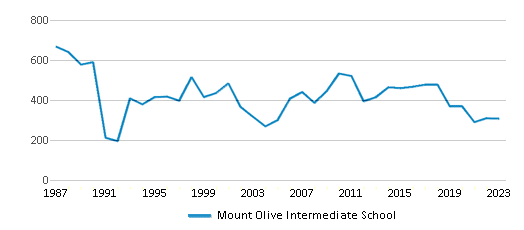
Gender %

Total Classroom Teachers
15 teachers
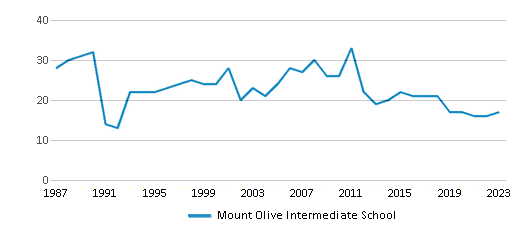
Students by Grade
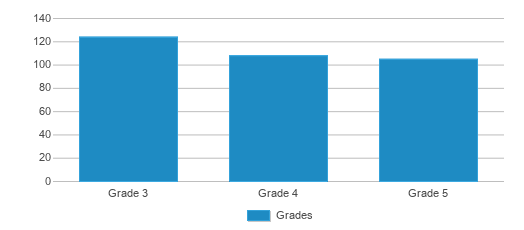
School Rankings
Mount Olive Intermediate School ranks within the top 30% of all 1,285 schools in Alabama (based off of combined math and reading proficiency testing data).
The diversity score of Mount Olive Intermediate School is 0.68, which is more than the diversity score at state average of 0.63. The school's diversity has stayed relatively flat over five school years.
Overall Testing Rank
#363 out of 1285 schools
(Top 30%)
(Top 30%)
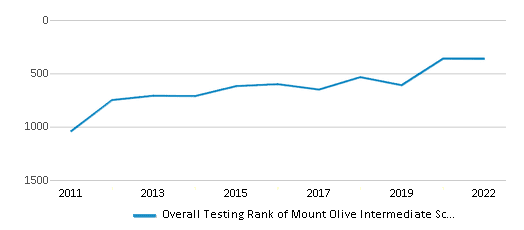
Math Test Scores (% Proficient)
27%
29%
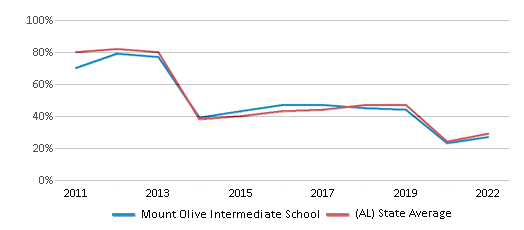
Reading/Language Arts Test Scores (% Proficient)
60%
47%

Science Test Scores (% Proficient)
40-44%
38%
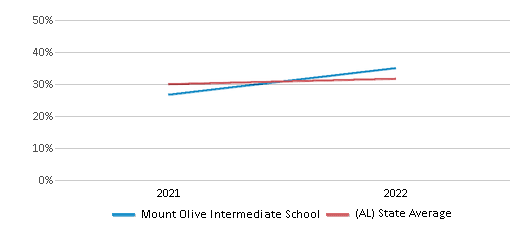
Student : Teacher Ratio
22:1
17:1
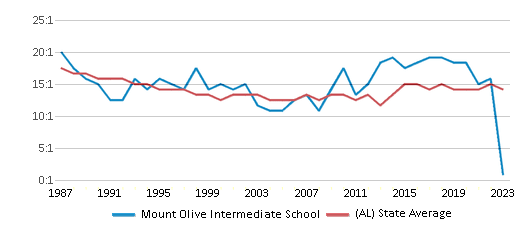
American Indian
1%
1%
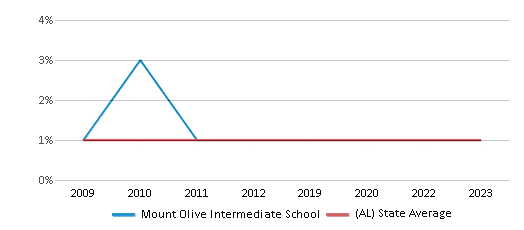
Asian
n/a
1%
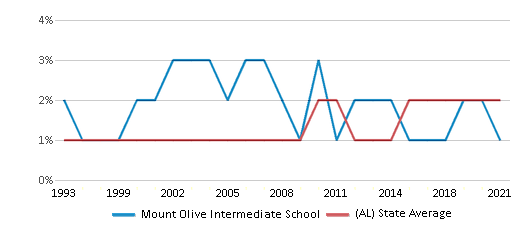
Hispanic
12%
11%
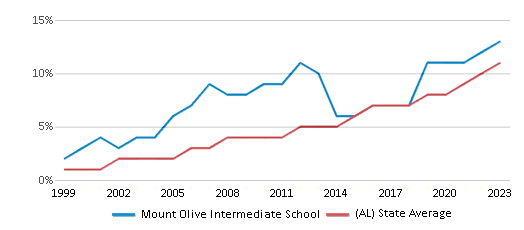
Black
46%
32%
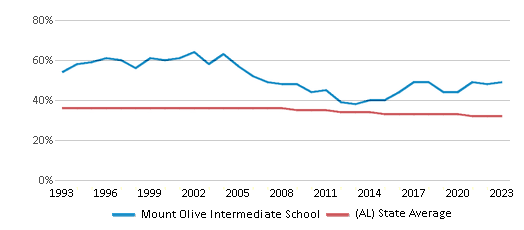
White
31%
51%
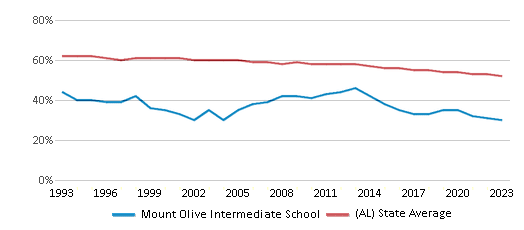
Hawaiian
2%
n/a
Two or more races
8%
4%
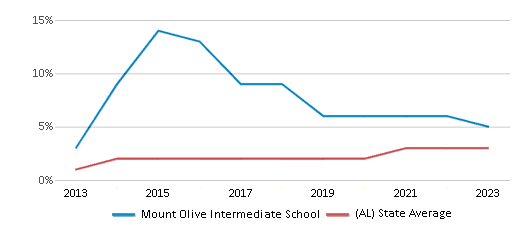
All Ethnic Groups
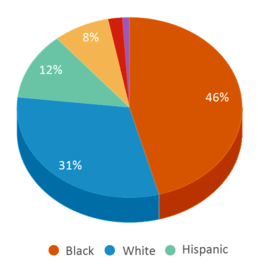
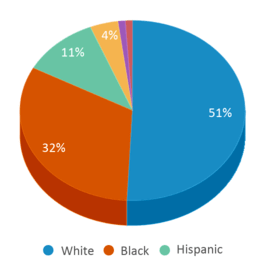
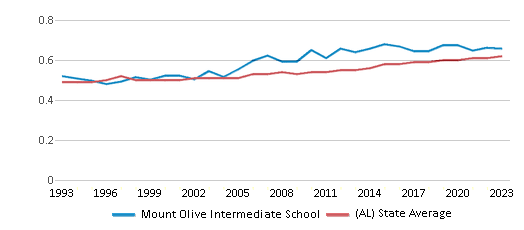
Participates in the National School Lunch Program (NSLP)
Yes
Eligible for Free Lunch
54%
56%
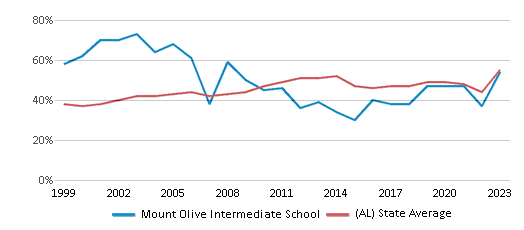
Eligible for Reduced Lunch
15%
5%
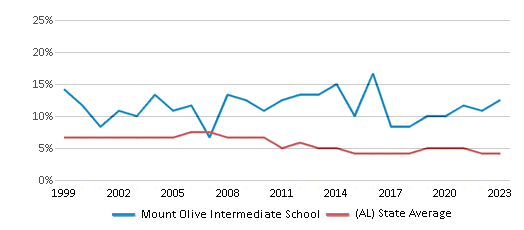
School Statewide Testing
School District Name
Source: National Center for Education Statistics (NCES), AL Dept. of Education
Profile last updated: 02/09/2025
Frequently Asked Questions
What is Mount Olive Intermediate School's ranking?
Mount Olive Intermediate School is ranked #363 out of 1,285 schools, which ranks it among the top 30% of public schools in Alabama.
What schools are Mount Olive Intermediate School often compared to?
Mount Olive Intermediate Schoolis often viewed alongside schools like Oliver Elementary School by visitors of our site.
What percent of students have achieved state testing proficiency in math and reading?
27% of students have achieved math proficiency (compared to the 29% AL state average), while 60% of students have achieved reading proficiency (compared to the 47% AL state average).
How many students attend Mount Olive Intermediate School?
337 students attend Mount Olive Intermediate School.
What is the racial composition of the student body?
46% of Mount Olive Intermediate School students are Black, 31% of students are White, 12% of students are Hispanic, 8% of students are Two or more races, 2% of students are Hawaiian, and 1% of students are American Indian.
What is the student:teacher ratio of Mount Olive Intermediate School?
Mount Olive Intermediate School has a student ration of 22:1, which is higher than the Alabama state average of 17:1.
What grades does Mount Olive Intermediate School offer ?
Mount Olive Intermediate School offers enrollment in grades 3-5
What school district is Mount Olive Intermediate School part of?
Mount Olive Intermediate School is part of Russell County School District.
School Reviews
2 12/6/2011
This school needs alot of improvement. We are a military family and my kids have been to a school in TN and KY. Compare to the schools they have attented, Mt. Olive is by far inferior. They had to cancel the open house and was re- scheduled after school had started. Many parents who were waiting in line on the first day of school complained about the cancellation. Another complaint is that my children's old school called me because nobody had requested their official form from Mt. Olive and it has already been a week since school started. This form was needed to verify if he was in the Gifted and Talented program. It's already December and one of my son is till not going to the Gifted and Talented class. Their reasoning is that they haven't scored them yet. Another complaint is that my kids said that everyone in class is loud all the time. They are not used to this. The teachers in other states kept them quite so they can learn. Here I don't think they care. At least the majority. Also, my son said only about 10 kids received honor rolls in his grade compare to more than 50% of the students in the other 2 states. That would be about 50 students. All i can say is that Mt Olive needs alot of improvement.
Review Mount Olive Intermediate School. Reviews should be a few sentences in length. Please include any comments on:
- Quality of academic programs, teachers, and facilities
- Availability of music, art, sports and other extracurricular activities
Recent Articles

What Is A Charter School?
Explore the world of charter schools in this comprehensive guide. Learn about their history, how they operate, and the pros and cons of this educational innovation. Discover key facts about charter schools, including admission policies, demographics, and funding, as well as what to look for when considering a charter school for your child.

10 Reasons Why High School Sports Benefit Students
Discover the 10 compelling reasons why high school sports are beneficial for students. This comprehensive article explores how athletics enhance academic performance, foster personal growth, and develop crucial life skills. From improved fitness and time management to leadership development and community representation, learn why participating in high school sports can be a game-changer for students' overall success and well-being.

February 05, 2025
Understanding the U.S. Department of Education: Structure, Impact, and EvolutionWe explore how the Department of Education shapes American education, from its cabinet-level leadership to its impact on millions of students, written for general audiences seeking clarity on this vital institution.







